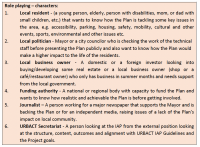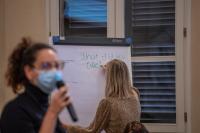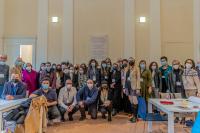
Can you have small scale actions before infrastructure developments and when to introduce them? Why include community in the urban planning processes – they are not experts, architects, urban planners, and traffic specialists? How can you introduce alternative mobility options in the hilly city? What green infrastructure solutions to introduce in the historical old towns that would not make conservationists cringe?
These and many more questions were a basis for lively and interactive discussions during the URBACT KAIRÓS - Heritage as Urban Regeneration project IAP Peer review workshop that took place in Cesena, Italy on November 17, 2021. My role as an URBACT Ad-hoc expert was to participate in the design of the agenda, methodology and to co-facilitate the workshop with KAIR S Lead expert, my colleague, Miguel Rivas. Not a difficult task when you have experienced experts with you such as Mr. Rivas and KAIR S project coordinator, Anke van Wijck, as well as a team of engaged partners.
After some discussion on the methodology, decision was made to use “Role playing” as one of the URBACT Peer review sessions methodologies that are always a safe bet for ensuring that even those less outspoken participants have a say. In this game, participants took a role of a different person relevant for IAP preparation and implementation like a resident, a business owner, a journalist or a politician. We also considered two other methods, De Bono’s “Six thinking hats” method where participants put on a hat of another person and the Disney method developed by Robert Dilts, which involves three different roles – the Dreamer, the Realist, and the Spoiler.
But what is the Peer review? In a very technical sense, a peer review is “a process where dedicated representatives exchange information and experiences on a specific topic for an effective policy or practice. The Peer Review process comprises a range of presentations and interactive working groups there are included visits to local sites where the policy can be seen in operation” (EU “Open Method of Co-ordination”). In a practical sense, it is a collaborative and interactive exchange of constructive and sometimes very direct comments by peers of the same or similar competences whose aim is to a) help their peers in improving the IAPs, b) become inspired and learn from other
peers’ experiences and c) further their collaboration with the peers.
The reviewing exercise was organized in a way that all partners had to read in advance the IAP of three other partners. A matrix with the proposal on “Who reads Who?” was prepared in advance by the Lead Expert. To ensure timely and quality facilitation of the reviewing process, in cooperation with the Lead Expert, I have prepared a detailed Facilitation guide and an explanation of the roles with a set of questions for easier preparations for the role-playing exercise. Discussion was conducted based on the following key questions: e.g. “Have the IAP addressed your needs as a local (resident, business owner…)?” “Where do you see the strengths of the IAP?”; “What could be improved?” etc. It has also evolved depending on the discussion and involvement of different “actors”.
As a facilitator, it was my role to ensure that communication stays on the desired path and to also involve all or at least as many participants as possible. It was an amusing exercise to decide on the characters and describe their roles, but at the end we have opted for more “usual” roles such as the ones in the below table:
Although most of the partners followed the IAP Guidelines, IAPs differed in each city depending on their goals, stakeholder involvement and other efforts. Issues ranged from the proposal of large infrastructure projects in Heraklion (Greece), to branding issues in Malbork (Poland), integrated tourism development in Belene (Bulgaria), revival of the train station and youth involvement in Cesena (Italy), creating community engagement framework in Ukmergė (Lithuania), regeneration of a derelict neighbourhood in Mula (Spain) and awareness raising/digital mapping efforts of cultural heritage in the Old Town of Šibenik (Croatia).
KEY ISSUES AND GOOD PRACTICES
During the workshop there were many issues and good practices presented related to cultural heritage as a driver for urban regeneration, which were submitted to comments and advice from designated peer-teams, and which could be presented here using the KAIRÓS five pillars:
I. GOVERNANCE
Participatory approaches for the heritage city were strongly present in the specific objectives of Ukmergė and Šibenik, which aim at reviving the Old Town, raising awareness about the cultural heritage, integrating participatory methodologies in the city policies, and developing activities with and for the local community rather than just tourists. Some interesting activities are to create a monthly free of charge booklet about Ukmergė’s architectural-urban values using simple and catchy language and establish Municipality award for investments in restoration of cultural objects in the old town for businesses and residents. In Šibenik, activities varied from the promotion of cultural routes led by the residents of the Old Town to the DIY workshops on heritage restoration and the “adoption” of heritage landmarks. Strong focus in Šibenik is also on using digital technology in the interpretation of cultural heritage and mapping stories of the Old Town.
II. SPACE
Key issues related to space such as mixed use in the historic quarters, re-thinking accessibility, using green and smart solutions were present in the Cesena IAP, which was focusing on the urban regeneration process for the area surrounding the railway station, currently undergoing urban and social decline. Some innovative activities identified with active participation of their many stakeholders were: a caf run by students and disabled people where they could eat, study or just socialize, urban trekking and an outdoor cinema but also green urban solutions and urban furniture to transfer the area into Gateway to and from the city.
III. ECONOMY
Using heritage as a driver for innovation, entrepreneurship and job creation was highlighted in the IAPs of Heraklion. Incentives to foster and attract young creative entrepreneurship in Aghia Triada, as drivers of economic growth included financing of micro and small companies, support to traditional, innovative, or artistic entrepreneurs but also the existing companies in the area. Šibenik is also rethinking the support to micro and small businesses by improving their online platform “Let’s go to the city” and promoting local businesses but also improving the existing offer through market development, promotion and revitalization of traditional crafts and eco-products in the eco-market.

IV. ATTRACTIVENESS
Re-imagining the heritage city: from local identity to destination management and branding the heritage city through storytelling and improved communications were key issues for the cities of Malbork and Belene. Both cities have a rich cultural and natural heritage but lack a strategic approach in developing an integrated tourist offer. They want to demonstrate that they could offer more than just events related to the medieval castle in Malbork or the Danube River attractions in Belene. Both cities need an overarching Tourism and marketing strategy with concrete actions on how to integrate their offer but also develop new cultural and other routes using storytelling (e.g. story of Marianek) and boost nature-based activities especially those on the rivers of Nogat in Malbork and Danube in Belene. They also need to improve information and communication and create a brand that could put them on the map as attractive, holistic, year-long destinations.
V. SOCIAL COHESION
Many issues such as affordable housing, gentrification, urban safety and security, management of vacant spaces and abandoned building, social and urban inclusion of the multi-ethnic environment were only some of the issues for the IAP of the city of Mula. Their IAP has focused on the revitalization of the Barrios Altos de Mula neighborhood, a medieval part of the city, which has fallen into a process of degradation. Through five objectives (infrastructure, energy and urban regeneration, green network, commerce, tourist offer and social inclusion), the city of Mula intends to improve the social fabric in this neighborhood by developing a dialogue with the community, improving accessibility, creating green spaces, promoting small local commerce and thereby gradually boosting its attractiveness for visitors.
LESSONS LEARNED
There were also few lessons learned that we all took home from the discussions:
▪ You don’t have to wait for finalization of the infrastructure improvements that usually take 5-7 years to implement small scale actions. As
▪ some placemakers say, “Start with petunias”, with small steps that bring
▪ community together and develop partnerships and trust.
▪ Participation matters but it must be meaningful. This means that rather than include community for the sake of a participation, participation should be used as a driver of change
▪ You need to have an overarching strategy especially if you have different elements that you want to integrate and promote like cultural and natural heritage.
▪ Governance is key to sustainable urban regeneration – it is important to explore different models of governance especially in the case of urban regeneration of large cultural heritage projects where the partnership among the public, private and civil sector is key.
▪ Live peer review sessions cannot be replaced by online meetings and workshops. Live meetings and exchange of knowledge is key to learning, networking and being inspired.
Overall, the role peer review session was extremely helpful for the partners as it gave them comments coming from a different, objective but meaningful perspective. The comparative analysis was also an opportunity to think about your own strengths and weaknesses. The peer review session also helped deepen the bond among the partners, create a stronger cohesion, which was diminished during the COVID-19 pandemic and ZOOM meetings, and last, but not least help improve their IAPs.
A most memorable moment was seeing the dedication and active participation from the Cesena High school students who have participated in the Kairos project and presented their green solutions for the railway station.

